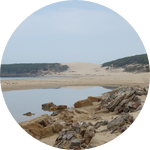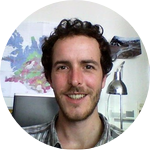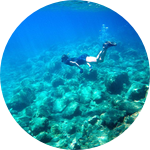About This Project
Knidos is an ancient settlement located in our modern-day Turkey. By the late 4th century BC, Knidos relocated their civic center. We want to know why. We will investigate possible sources of environmental stress that caused the relocation. We hypothesize that the move may have been due to the limitation of freshwater, submersion of docks, or a potential contribution of natural disasters such as earthquakes tsunamis and storms.
Ask the Scientists
Join The DiscussionWhat is the context of this research?
Old-Knidos initiated around 700 BC as a mid-sized harbor servicing a small fertile hinterland, half way along the Datça peninsula in Turkey. The outstanding success of Knidos, however, came from its location at the intersection of the Mediterranean and Aegean seas, a strategic place where changes in prevailing winds resulted in long stopovers. This led to the development of a flourishing trading business. By the late 4th century BC, New-Knidos was founded as a centre of civic, religious, and cultural activity, but the old settlement remained in use. As a result, the decision to move the civic centre down the Datça peninsula may have been contemplated for many years before the decision was made, following a particular event not recorded in the historical or archaeological documents.
What is the significance of this project?
Our world currently faces environmental changes that challenge the ability of humankind to adapt social and economic practices to a finite, limited planet. Earlier civilizations were also repeatedly confronted to such situations at more restricted scales. Depending on their degree of resilience, some survived, other declined. Survival and collapse of civilizations has long fascinated scholars, because it offers a range of possible outcomes that can help to understand modern challenges and predict future patterns. More specifically, the obtained results also shed a new light on the demise of other harbors along the coasts of southwestern Turkey in Caria and Lycia, which are similar to those of Old-Knidos.
What are the goals of the project?
While a lot of research has focused on harbour decline, this project aims at documenting a case of successful adaptation in the form of city relocation in the southeast Aegean. We aim at testing the possibility that natural phenomena contributed to, and eventually forced this decision. To do that, this geoarchaeological project, on the other hand, aims at assessing long-term soil erosion, water supply fluctuations, harbor siltation, and at identifying sudden events such as earthquakes, storms, tsunamis, and coseismic ground subsidence. Long-term trends and punctual events will be compared to on-site archaeological findings to establish correlations between environmental forcing on the one side, and economical and civil activities on the other.
Budget
We have conducted fieldwork in August 2015, and a 2.50 m-deep sondage was excavated in the ancient harbor of Old-Knidos along the Datça peninsula in southwest Turkey. The funds requested from the archaeology grant challenge on Experiment will be used to pay the cost of lead isotopes and trace and major elements analyses conducted on nearly 30 samples of sediments. These kind of analyses should be able to assess the city’s accessibility to freshwater, as well as the dynamics and palaeo-environmental changes in the water column of the ancient harbor basin. We request also radiocarbon datings in order to establish the chronostratigraphic framework of these deposits. The remaining funds will be used to pay for the cost of one to two months of salary for a technician qualified in these kind of geochemical analyses, as well as the needed lab material. This project will be completed by the valorization of the results through publications and congress requiring also costs.
Endorsed by
Meet the Team
Affiliates
Affiliates
Hugo Delile
Hello everyone, I am currently working under a post-doctoral position at the University of Lyon involved in the PortusLimen Project. My research concerns the harbor geoarchaeology, which focuses on the study of Human-environment relationships in long-term through sedimentary archives in which measurements of multidisciplinary proxies are done. More specifically, my research is focused on geochemistry and sedimentary processes that shape the moving coastal environment of ancient settlements during the last millenia, and especially the ancient harbor basins of the Mediterranean. Of particular interest is the development of new tools in harbor geoarchaeology, especially:
- lead palaeo-pollutions trapped in ancient harbor sediments for tracking the long-term evolution of the ancient cities' water supply networks (Rome, Ostia, Naples, Ephesus, etc.);
- the major, trace and rare earth element geochemistry applied to coastal sediments for palaeoenvironmental reconstructions.
Jean Philippe Goiran
I am research scientist at CNRS – University of Lyon, expert in ancient harbor geoarchaeology. My research arises from the realization that due to silting up process, many Roman harbor basin sites were perfect sedimentary traps that have been in-filled with a range of deposits that are well suited for palaeo-environmental studies. My methodological approach is upon the laboratory-based analysis of sedimentary cores drilled into these ancient basins. These cores present with what amount to sedimentary archives that are studied by a pluridisciplinary team, and provide us with a lot of information about past envıronmental conditions, as well as the characteristics of the harbor basins themselves (depth, life-span, rate of infill, phases of dredging etc..). I have been involved in developing thıs approach at key ancient Mediterranean harbors in marine, lagoonal or fluvial contexts.
I have also been involved in researching into the evolution of past landscapes, and in particular, contributing to our understanding of the geography of ancient coastlines. My work has considered variations in sea-level, fluvial inputs, tectonic movements and human modifications (breakwaters…). For example, in one project we have been able to demonstrate that the rocky hill of the Piraeus near Athens was originally an island, while sedimentary archives from drilled cores confirm the historical text of Strabo. We did similar work on the ancient island of Ougarit (Ras Ibn Hani, Syria) and on the Pharos island at Alexandria in Egypt.
Last but not least, I have made contributions to the study of lead traces relating to ancient occupation and human impact at port sites. At Alexandria, we have been able to prove the existence of an ancient phase of occupation dating to the middle of the 2nd millennium BC, well prior of the foundation of Alexandria by Alexander the Great. We have also been able to gauge the rate of lead palaeo-pollution ın the ımperıal harbor of Rome (Portus).
Lab Notes
Nothing posted yet.
Additional Information
As part of this project, we are working with many partners, including the underwater team from the universities of Brock and Stanford in collaboration with Prof. Dr. Numan Tuna from the Middle East Technical University, as well as Prof. Dr. Helmüt Bruckner and Dr. Friederike Stock from the University of Köln.
Recent works done by our geoarchaeological team were relayed by media:
About Naples:
http://www.bbc.co.uk/programmes/p03tw2vm (please, listen from the 6th minute)
https://news.cnrs.fr/articles/ancient-naples-the-writing-on-the-wall
http://www.sciencemag.org/news/2016/05/roman-plumbing-wrote-record-mount-vesuvius-s-eruption
http://www.nationalgeographic.fr/27889-quand-la-pollution-au-plomb-raconte-naples/
About Rome:
http://www.sciencemag.org/news/2014/04/scienceshot-did-lead-poisoning-bring-down-ancient-rome
https://www.theguardian.com/science/2014/apr/21/ancient-rome-tap-water-contaminated-lead-researchers
http://phys.org/news/2014-04-tap-water-ancient-rome-local.html
https://news.cnrs.fr/articles/bringing-the-ancient-port-of-rome-back-to-life
About Piraeus:
http://www2.cnrs.fr/en/1872.htm
http://www.cbsnews.com/news/strabo-ahead-of-his-time-by-nearly-2000-years/
Project Backers
- 3Backers
- 1%Funded
- $11Total Donations
- $3.67Average Donation





